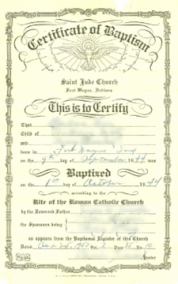Beginning January 31, 2008 the Department of Homeland Security is:
- Ending oral declarations at the border, except in extraordinary situations
- Accepting a list of about two dozen types of documents at the border instead of the over 8,000 documents currently being accepted
 On December 30, 2007, a man by the name of Coronado Paez tried to enter the United States. He presented a State of California identification card and orally claimed to be a U.S. citizen. Officers suspected Garcia was not the rightful holder of the identification card and referred him for a more in-depth inspection. A routine data query and fingerprint check revealed that the man was actually Mexican-born Andres Garcia-Landeros and was wanted for homicide in California. Garcia was transported to the custody of the San Diego Sheriff's Department.
On December 30, 2007, a man by the name of Coronado Paez tried to enter the United States. He presented a State of California identification card and orally claimed to be a U.S. citizen. Officers suspected Garcia was not the rightful holder of the identification card and referred him for a more in-depth inspection. A routine data query and fingerprint check revealed that the man was actually Mexican-born Andres Garcia-Landeros and was wanted for homicide in California. Garcia was transported to the custody of the San Diego Sheriff's Department.
Ending Oral Declarations of Citizenship at Land Border Ports of Entry
U.S. Customs and Border Protection must end the practice of allowing certain travelers to rely on oral declarations alone when entering the country. CBP must make it difficult each and every time for those who want to illegally enter the United States, by falsely claiming to be a U. S. or Canadian citizen when, in fact, they are not.
- There were 31,060 oral false claims of United States citizenship at U.S. land border ports of entry for fiscal years 2005–2007
- From October–December 2007 alone, CBP reported 1,517 cases of individuals trying to enter the U.S. by falsely claiming to be U.S. citizens
- The Government Accountability Office reported inspectors at land border ports intercepted nearly 15,000 people in 2002 who falsely claimed to be U.S. citizens in order to gain illegal entry, suggesting an unknown number of travelers successfully entered the United States this way.
New Document Procedures
New document procedures identify about two dozen types of documents that travelers may use to prove citizenship and identity while at the same time enabling CBP to quickly and confidently identify all travelers attempting entry to the United States.

New document procedures eliminate the use of insecure, paper identity documents such as social security cards, voter registration cards, certain health cards, and baptismal documents, as the requirement now calls for all identification documents to include a photo, name, and date of birth.
Reducing the Types of Acceptable Documents for Entering the United States
It is critical that all individuals seeking to enter the United States become acclimated to presenting documents to U.S. Customs and Border Protection (CBP) officers. Single documents proving both identity and citizenship, which are acceptable on January 31, 2008, will also likely be acceptable when the Western Hemisphere Travel Initiative is implemented.
"U.S. Customs and Border Protection faces a much greater challenge to identify and screen individuals at land ports of entry, in part because of the lack of advance traveler information and the high volume of traffic at many locations. Unlike travelers who enter the country at airports, travelers entering through land ports of entry can arrive at virtually any time and may present thousands of different forms of documentation, ranging from oral declarations of U.S. or Canadian citizenship, driver’s licenses, birth certificates, passports, visas, permanent resident cards, or U.S. military identity cards."
from Border Security Report, November 2007
Government Accountability Office
Single Document Option Proving Identity and Citizenship
A single document option exists for U. S. and Canadian citizens to prove both identity and citizenship – a single-document option is encouraged now and in the future for frequent land border crossers to expedite processing.
Two Document Option
Those travelers who do not have one of the single-document options must present both an identification document and a citizenship document. This dual document presentation gives U.S. Customs and Border Protection greater confidence in the traveler’s claim to identity and citizenship.
